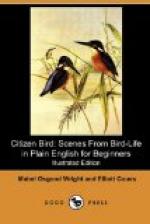“The Flicker has a jolly laughing call that sounds like ‘Wick-wick-wick-wick!’ repeated very quickly, and he also hammers away on a tree in fine style when he wishes to call his mate or let her know his whereabouts. Like other Woodpeckers, he hollows out a soft spot in a tree until he has made quite a deep hole, which, with a few chips in the bottom for bedding, serves as his nest. Most little Woodpeckers climb up to the hole-edge to be fed; but young Flickers are fed in the same way as little Hummingbirds, the parent swallowing food and when it is softened bringing it back from the crop by pressing on it with the beak.”
“What is the crop?” asked Dodo.
“It is an elastic pouch in the gullet of a bird, where food that has been swallowed is kept for a while before it goes further down into the stomach. You have seen this crop in the necks of Chickens and Pigeons.” “Oh, yes, a round swelled-up place; but what is the good of it?” persisted Dodo.
“It is a resting-place for food, where it may swell, soften, and be partly ground up. All birds are fond of eating sand and gravel.”
“Oh, yes! My Canary picks up lots of little bits every time I put fresh sand in his cage.”
“This gravel mixes with the food and helps to grind it up. You ran understand how necessary this is when you remember that some birds, like Pigeons, swallow hard grains of corn entirely whole.”
“Yes, and I saw Mammy Bun clean a Chicken yesterday,” said Nat; “there was a lot of sand and corn in a lump in its throat—and so that’s called a crop?”
[Illustration: Flicker.]
“To return to the Flickers: they live in flocks in autumn, and when a number are feeding on the ground at a little distance they might be taken for Meadowlarks—so you see that you did not make such a dreadful mistake after all, little girl.”
“Won’t you come over to the miller’s woods with us, uncle, and perhaps we can find the Downy’s nest hole,” said Nat.
“Yes, I will come and tell you about the fourth Woodpecker on the way—the one called the Yellow-bellied Sapsucker. Though very handsome, this is not a bird that you would care to have come in great numbers to your garden or orchard. For this bird makes holes in the tree bark and eats the sap that leaks out, from this habit gaining the name of Sapsucker. Of course you see that this is a very bad thing for the trees; for when a great many holes have been bored near together the bark loosens and peels off, so that the tree is likely to die. The Sap-sucker also does harm by eating the soft inner bark which is between the rough outside bark and the hard heart-wood of the tree; for this soft bark is where the sap flows to nourish the tree.
[Illustration: Yellow-Bellied Sapsucker.]




